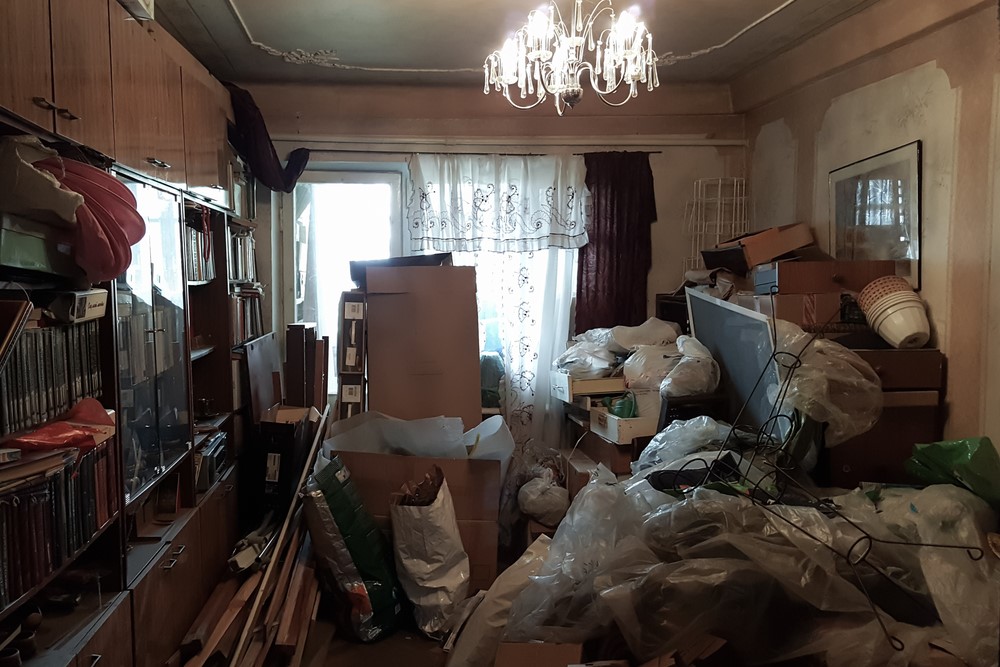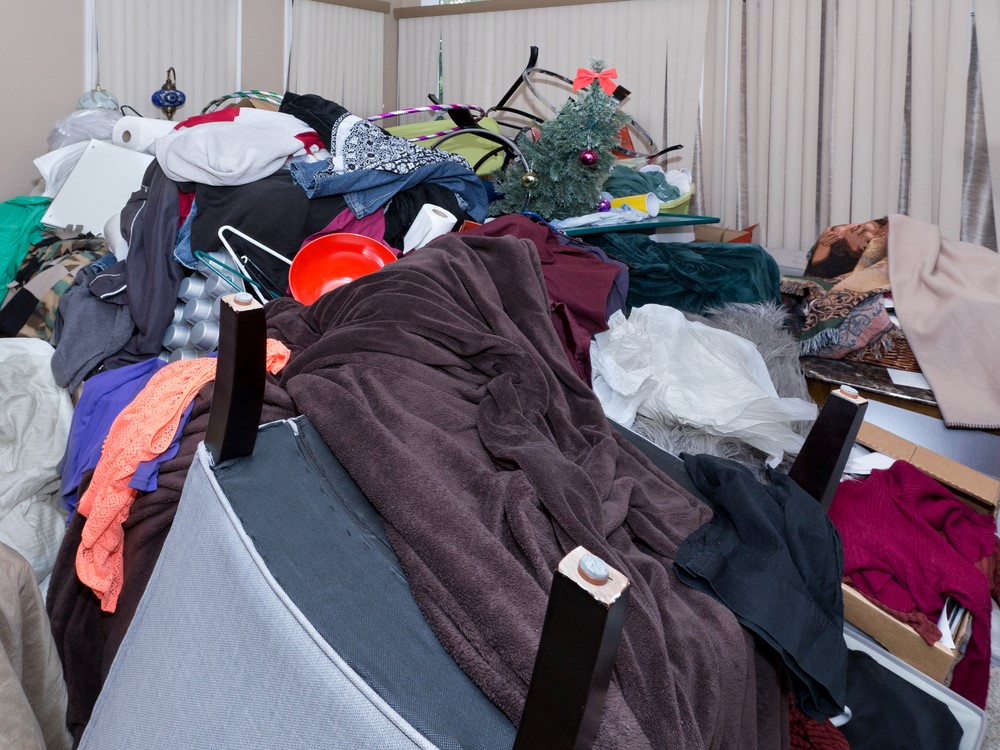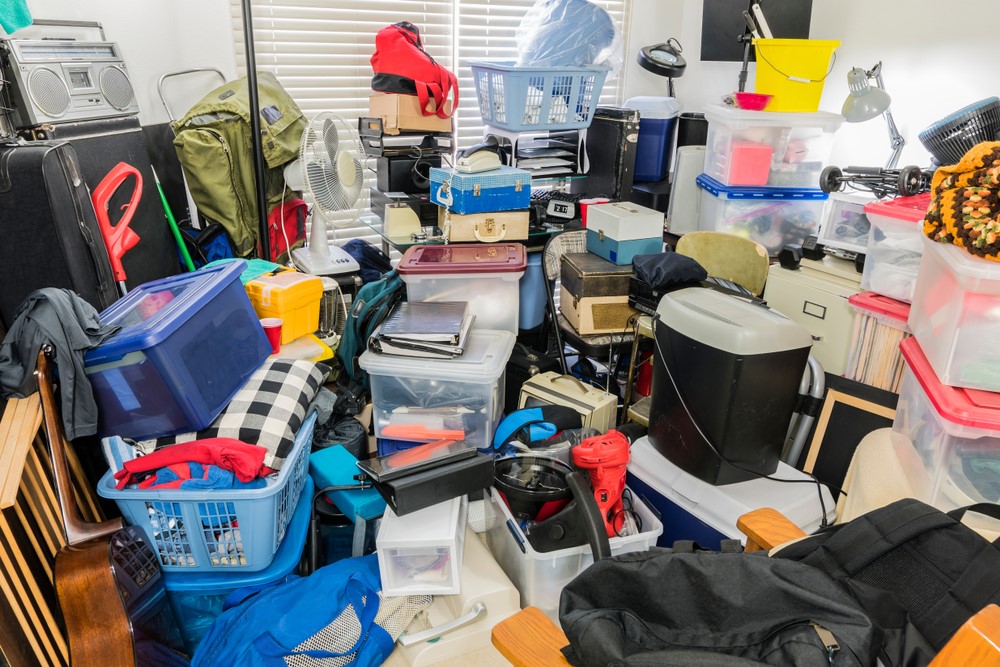TV shows like Hoarding: Buried Alive have trivialized hoarding (and put it in the public eye), but hoarding is a serious, long-term problem for the person who suffers from it, the people who live with them, and the loved ones in the picture. Solving the problem isn’t as simple as decluttering a room or a house either.
The topic is particularly concerning for adult children, who may be dealing with seniors and hoarding behavior. What do you do when your parent’s habit of collecting becomes overwhelming and harmful? How do give them a safe living environment when they don’t see any problem at all?
Those questions, and more, are what we’re going to answer today.
What is Hoarding?

The Diagnostic and Statistical Manual of Mental Disorders (DSM-5) now places hoarding disorder in its own category. Persons with a hoarding disorder may be terrified of discarding their possessions and experience severe anxiety over doing so. No matter how little value items appear to have, they continue to accumulate them, compromising their health and safety in the process.
Hoarding, according to the DSM-5, is distinct from other conditions. That is, the hoarding cannot be attributed to other medical conditions, such as a brain injury, or result from other mental disorders, such as obsessive-compulsive disorder (OCD), delusions in schizophrenia, autism, or major depressive disorder.
Getting at the root cause of hoarding and intervening with compassion is essential to helping the person in your life overcome their condition and improve their quality of life.
Seniors and Hoarding
Usually, hoarding disorder starts in early adulthood and worsens with age. Some researchers report that hoarding disorder is more common and severe among seniors, and diagnoses increase by about 20% every 5 years of age.
However, some researchers believe that rates may not actually be increasing with age. Rather, the effects of hoarding are more visible, because seniors have had more time to accumulate a large volume of things and because worsening physical and mental health make it more difficult to discard and purge items.
8 Important Ways You Can Help
Your instinct may be to step in with a forklift and purge to your heart’s content, assuming that the person with hoarding disorder will thank you. This is the worst thing you can do. You’ll be viewed as enemy #1 and met with hostility
Plus, after forceful interventions, most people go back to hoarding, as you’re not tackling the root cause of the problem. Instead, take a step back, get your resources in place, and approach your loved one with empathy and respect. It helps to remember that while the causes of seniors and hoarding behaviors aren’t fully understood, there are underlying causes. There’s more going on than your loved one just
Following these approaches to get to the root cause of their hoarding behaviors, arrange for ongoing community support, and begin the purging process is a good place to start.
1. Build Trust Before Intervening
You may have provided reliable help in the past and demonstrated a genuine interest in your family member’s well-being. Many people assume that their relationship with the hoarder is already based on love and trust.
Never assume this personal history will withstand an intervention for hoarding disorder or give you the green light to begin purging their possessions. Seniors may believe their adult children are simply wanting to remove items to prepare their home for sale or move them into an assisted living facility. Or they could assume that items removed will be put up for sale, for others to profit.
The best way to start is to be patient. Verbalize that you will respect your loved one’s decisions about the cleaning process and show this in your actions. Create a plan together and follow good conversation strategies with the senior.
Avoid using underhanded tactics to remove items from the home. This will only create tension in your relationship with the senior and set back any progress. Be as transparent as possible with what you are removing and where it’s going.
2. Seek Reinforcement

It will take a village of people to create a supportive environment that is conducive to change and improve the senior’s prospects of fully recovering. Family members, friends, mental health professionals, elder service agencies, and friendly neighbors will be essential in providing resources and support to help them with overcoming hoarding behaviors and maintaining a healthy space in the long-run.
Research studies stress that psychiatric interventions alone will not suffice. Ongoing home visits from community workers at local social service organizations are critical to helping seniors execute on guidance offered through therapy.
Cognitive-behavioral therapy (CBT) is the best-known treatment for someone with a hoarding disorder. Yet, completion of the therapy isn’t great if patients don’t follow through with homework in between sessions.
Finding available therapists can be difficult and paying for therapy can be difficult as well.
A broader range of formats is still needed to make this therapy easier to complete and more accessible. Helping people change their thoughts and beliefs about hoarding is one of the main goals of the CBT. Motivational interviewing and organizational skills training also help people overcome hoarding.
Even after a successful intervention, regular professional involvement is needed to maintain the senior’s mental stability, monitor their needs, get the right services in place, and coordinate care between service providers.
3. Rule Out Other Conditions with Professional Input
Although there is no permanent solution for this syndrome, various approaches and tactics have shown success in controlling hoarding. Be willing to engage a therapist to walk you and your loved one through the process. Mental health professionals can assist with identifying underlying or related conditions to better formulate a course of action.
Like many other mental health disorders, there are often overlapping traits that make hoarding difficult to diagnose. Hoarding disorder is now viewed as a separate condition, but it doesn’t stop many people from dismissing it as a symptom of other known conditions.
A proper assessment and diagnosis can be the key to finding the best solution, whether that’s skills training, cognitive behavioral therapy, medication, or a combination thereof. These are just a few examples of conditions that could mask or mirror common behaviors seen with hoarding.
Obsessive-Compulsive Disorder
Hoarding used to be a subtype of obsessive-compulsive disorder (OCD) as a part of the diagnostic criteria. Yet, one study found that only 16% of adults that were hoarding met the criteria for OCD. Further, other research has found that people with OCD who were hoarding were less responsive to exposure and response treatment.
Loneliness
Another factor that may contribute to hoarding is loneliness. The lack of engagement in social activities can limit cognitive stimulation and lead to hoarding behaviors.
Mental health researchers predict that isolation from COVID-19 lockdowns and quarantine measures will take a heavy toll on the emotional health of the population, including an increase in hoarding behaviors.
Dementia
Many doctors and psychologists believe that dementia puts seniors at risk of hoarding. Several studies of older adults show an association between hoarding behaviors and dementia.
This framing is somewhat flawed. Some seniors with dementia will display some aspects of the disorder, such as collecting and hiding food and objects. However, these studies did not assess the senior’s difficulty with discarding items, which is another important indicator of hoarding. Adding to the complication of diagnosing a person with dementia with hoarding disorder, is that hoarding itself can increase the risk of dementia in later life.
SDAM
Lesser known conditions, such as Severely Deficient Autobiographical Memory (SDAM) and aphantasia, create difficulty with visualizing past experiences or events. This condition could cause people to collect items as a way to trigger their memory.
Holding on to certain possessions may have more functional purposes in these cases. Less than 1% of the population is estimated to have SDAM and aphantasia, and hence, there is limited research connecting SDAM to hoarding behaviors.
Attention Deficit Disorder with Hyperactivity (ADHD)
In a study with a matched control group, investigators found that about 20% of adults with ADHD exhibited signs of hoarding behaviors (compared to just 2% in the control group).
This was linked to their general inattention, referring to being easily distracted and having difficulty with organizing and executing tasks.
4. Provide Emotional Support
Parting with most objects will cause intense emotional reactions from the hoarder. Distress is a known symptom of hoarding disorder. Checking in on them regularly and rooting them on can keep them motivated.
Be prepared to listen to their concerns and take note of worsening depression or anxiety as you move along the process. Revise the plan, as needed to minimize the emotional toll on them.
5. Start with Critical Spaces

People who hoard will have accumulated things in most corners of their home, inside and outside. Talk with them about their daily activities and where they are currently experiencing the most difficulty.
Prioritize areas that will have immediate big wins that they will feel. For example, if they’re having trouble showering because of clutter in and around the bathroom, start there. If their sleeping area is no longer functional because the bed is piled high with clothes or other items, start there.
6. Set Small Attainable Goals
Trying to help an extreme hoarder clean and organize their home is a big job, and many people will find it hard to deal with the amount of work it will take to do it. Consider how quickly your loved one can clear out their things.
Keep them from feeling overwhelmed by breaking down the project into small, attainable goals. It should also make you feel like you did well when you finished on any given day.
7. Check Your Own Emotions
It is vital to treat the hoarder as a friend and with the utmost respect. Face their frustrations, and yours, with compassion. You may be the target of a hoarder’s rage when they consider giving away or disposing of their possessions.
Make sure you have a safe place to vent and express your emotions. Again, turn to your village of supporters and professionals for guidance along the way. There’s plenty of support out there, especially as seniors and hoarding is a surprisingly common problem.
The process of reclaiming an elderly hoarder’s home and making it a healthy place to live is a lengthy one but is possible.
8. Celebrate the Smallest Achievements
Every minor achievement should be celebrated, even if it’s just getting rid of piles of old newspapers. They are more likely to realize that parting with things doesn’t have to be as painful as they thought when reaching a happy goal.
You can give your loved one positive feedback to help them become more confident and help them improve their decision-making and organizing skills.
When Should You Call Adult Protective Services?

Perhaps you’ve been there all along, watching as the senior’s hoarding slowly ballooned out of control and were able to step in before a crisis.
However, sometimes seniors become pros at hiding their hoarding practices. This can mean that extreme hoarding that compromises the senior’s health, safety, and home is noticed too late. It’s only once neighbors have voiced their complaints, fines are issued from the city, or there is a looming threat of eviction that hoarding comes to the fore.
When conditions worsen to a point where the senior’s health and safety are at risk, the intervention timeline has to be moved up quickly. The home environment may have become hazardous to the senior’s health. The toilet may be clogged, or accumulated trash may now be attracting rats and roaches. Mold and animal feces may be aggravating the senior’s health conditions, such as asthma or COPD.
In some cases, it will be necessary to call Adult Protective Services in your County or State and file a report, such as when a senior meets the definition of ‘self-neglect.’ Self-neglect can include living in a hazardous living environment, suffering from malnourishment, or failing to address their critical medical needs.
Elder service organizations working in partnership with local Area Agencies on Aging can help find alternative housing when the senior is close to being evicted.
- The person may be at risk of being evicted if they are renting, if the homeowner determines that the resident has caused significant damage to the home or neglected to report or fix issues in a timely manner.
- If they own their home but live in a community monitored by their homeowner’s association (HOA), they could be subject to continued fines until they resolve the issue. Fees could get out of control or lead to legal troubles. HOA’s are known to fine homeowners for even the most trivial things, such as leaving Christmas lights after January, leaving a pile of leaves for too long, or not putting in your trash bin within 24 hours of trash pick-up.
The person may have received notices or fines from their City ordinance following complaints from neighbors about the unsanitary conditions of the premises or due to health code violations. They can get into a heap of legal and financial troubles if this is not resolved.
Many Area Agencies on Aging can refer seniors and families to low-cost or pro-bono elder law professionals to prevent or address legal action.
Conclusion
In sum, getting the proper reinforcements in place in the form of professionals and community is essential to resolving hoarding behaviors.
The characteristics of hoarders can overlap with other mental health disorders, making it crucial to get a professional evaluation to create the best plan possible.
Hoarding can place an older adult’s health and safety, and their home at risk. A cautious approach to intervening must be balanced with crisis control.
Many older hoarders don’t have good executive functioning skills, which means they’ll need mental health support and housekeeping help for a long time. Ideally, providers and agencies will work together with the senior and close family to provide ongoing assistance.
Feeling Overwhelmed?
Check out our Caregiving Consulting service for personalized support and guidance.

Leave a Reply